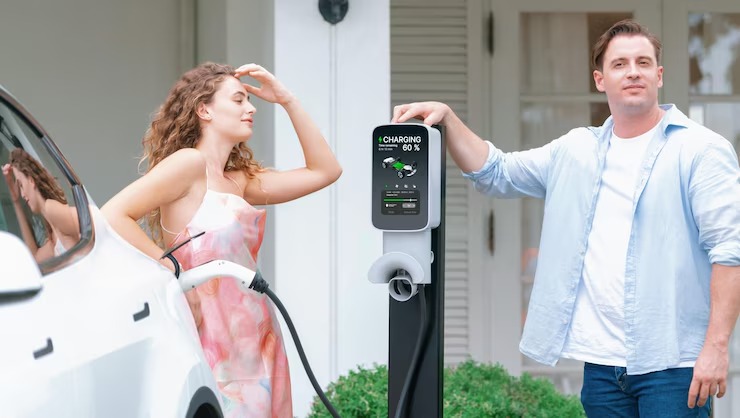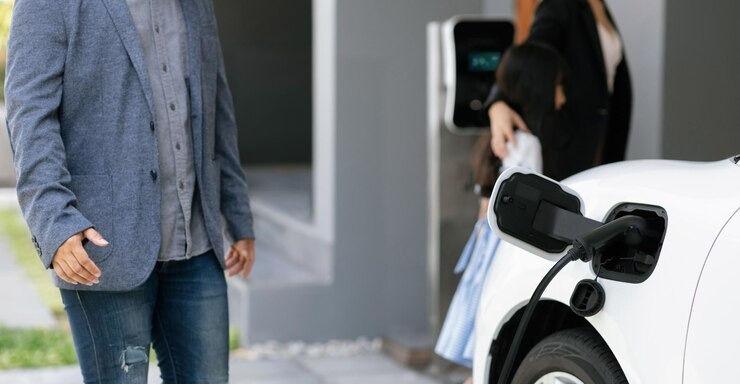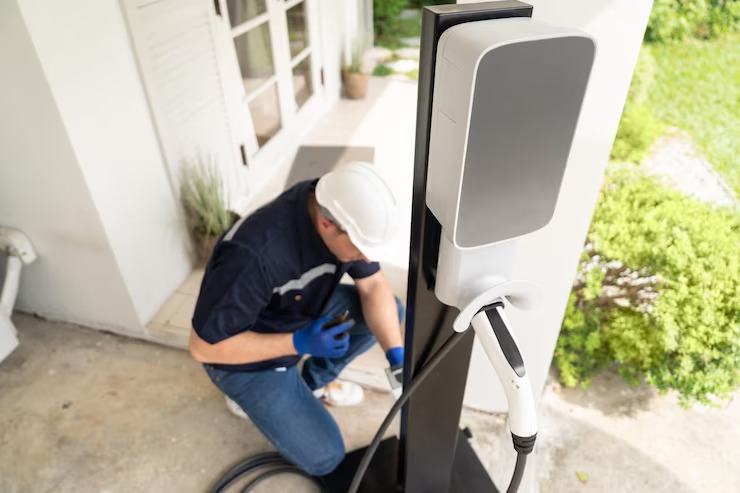Charging an EV should be as simple as plugging in your phone. It doesn’t require any special knowledge or advanced skills. But what should you do when you’ve plugged it in and nothing happens? It leads you to wonder, “Why is my EV car charger not working?” especially when everything seems fine.
The reasons can range from not having plugged in properly to sudden malfunctions. Is it something that requires the attention of a skilled EV mechanic, electrician, or can you DIY troubleshoot and rectify it yourself?
Here’s all there is to know, including common reasons an EV charger won’t work, how to troubleshoot, and fix the issue.
Common Reasons an EV Charger Won’t Work

The most common reasons for an EV charger not to work have something to do with the setup, not you.
Power Supply Issues
EV chargers come with specific voltage and current ratings that must be met for them to work efficiently. For instance, some Level 2 chargers require 40 amps and 240V to function optimally. Newer models can demand 500 amps and at least 1,000 volts.
Older homes often have 100A panels that trip when EVs engage 30 – 50-amp circuits. A common fix to this issue is upgrading to a 200A service or installing a load balancing tech that can limit power automatically during peak loads.
Faulty Charging Cable or Connector
A damaged cable can cut your amperage instantly. Damage can occur if the cable is stored improperly or mishandled between sessions. Falling to the ground could make them accumulate wear and tear. Also, placing them in extreme temperatures or damp conditions could lead to damage.
The cable is just part of the whole charging circuit, so damage to it interferes with connectivity between the vehicle and the charger. To avoid damage, always store the cable in a safe place after every use and follow EV charger cable management best practices. Apply specialised cleaners if you notice residue or debris on the charger that could cause rusting.
Charger Malfunction
Just like most other devices, EV chargers can also wear out. Even high-quality ones can have internal issues like burnt relays, dead fans, and cracked circuit boards. Public chargers in busy stations wear out faster than those in homes. Always pay attention to unusual sounds and error lights signaling a malfunction.
Vehicle Side Issues
Your EV’s battery management system (BMS) can refuse a charge if, for instance, the battery is too cold or hot. Sometimes, a software lock pending charging can also cause the charger not to work. If this happens, no need to freak out; simply check your EV charger app, and you’ll be surprised to find that your car is just “thinking.”
Environmental Factors
The answer to “Why is my EV car charger not working?” may have something to do with the environmental factors. Maybe you plugged in after a hailstorm. If that’s the case, the connector might be wet, have an extreme temperature, or the cable could be damp. All these are factors that could easily trip the safety sensors. While most connectors have an IP54 waterproof and dust resistance, they aren’t invincible.

User Errors
Believe it or not, sometimes people don’t fully insert the plug or flip the breaker back on. If you notice your car charger is not working, before going any further, first double-check your connections and power switches.
Step-by-Step Troubleshooting Guide
What should be the next course of action to find the problem with your car charger? Next is a quick step-by-step troubleshooting guide to help you get back to normal.
Step 1: Check the Power Source
Ensure your breaker or fuse isn’t tripped. Test other outlets or devices on the same line. If your panel is old, consult an electrician.
Step 2: Inspect the Charging Cable and Connector
While doing the inspection, look for frays, bent pins, or exposed wires. Use a clean, soft brush to remove debris or residues. If there’s visible damage, replace it. The cost of repairs or replacements varies according to the damage, but can range between $100 and $1,000.
Level 1 chargers can cost $300 – $600, while Level 2 chargers cost between $500 and $700. DC fast chargers are the priciest, and can start from $12,000 to $45,000. Before choosing to buy a new charger, compare its cost to that of repair, and you might end up saving more money.
Step 3: Reset the Charger
Sometimes, the reason for a problematic EV charger is just a minor software glitch that can be done away with through a reset. To do that, turn off the charger, unplug it, and wait for about 30 seconds to a minute, then power it back on. Most faults clear with a simple reboot, just like your laptop.
Step 4: Check Vehicle Settings and Battery Status
Like we mentioned earlier, EV battery conditions like temperature matter a lot during charging. Look in your EV app or dashboard. Is the temperature too low? Are you in off-peak charging mode? Software updates or active charge limits may also block charging.
Step 5: Try Another Charger or Outlet
The problem could be that your charging equipment, either the outlet or the charger, is faulty. Try plugging in to a different charger or outlet and see what happens. Drive to a friend’s house with the same EV charging setup or a public charging station and try a different outlet or charger. if things are working fine elsewhere, then the problem is site-specific.
Step 6: Update Firmware and Software
Are there pending software or firmware updates that you’re not aware of? Check your vehicle dashboard or charger app for any updates. The cause of the charger not working could be a bug or a quirk that can be sorted out by running updates.
Safety Tips While Handling EV Chargers
Safely handling your EV charger can make a big difference in avoiding charging troubles. Here are a few safety tips while handling EV chargers to keep avoidable issues at bay and charge seamlessly when it’s time to juice up:
- Always disconnect power first – Before touching any cables or working on breakers, ensure the plug is disconnected or the power switched off.
- Keep it dry – Unless you’re indoors, you should charge your car when it’s raining. Wet charging gear increases the risk of an electric shock, even for IP54-rated equipment.
- Use only certified equipment – Using certified or UL-Listed OCPP/ISO 15118 chargers can prevent a good number of compatibility problems often caused by alternative options.
- Do monthly cable inspections – Look for exposed metal, cracks, or extreme wear.
- Carefully handle plugs – Avoid yanking cables out; twist them gently to disconnect. Yanking can damage seals or bend pins.
- Check for Defects or Recalls – Sometimes, manufacturers may deem certain charger versions as faulty and recall them. The best way to stay updated when such recalls happen is to sign up for good chargers and EV apps to receive alerts.
- Never DIY repairs – Some of us just love DIYing literally everything. Well, when it comes to your EV chargers, you might want to pause on that. Leave repairs inside the charger shell to pros.
Specific Issues with Different Charger Types
Another important part of the EV charging issue you need to be aware of is the specific quirks according to the type of charger.
Level 1 Chargers
The common drawback with Level 1 chargers is that they’re as slow as molasses. Plugging into a normal outlet at 120V can only add about 2 to 5 miles per hour. While this might be a non-issue to your battery, the same doesn’t apply to cables. There’s the risk of extension cords overheating, or the household circuit might get overloaded.
Level 2 Chargers
Level 2 chargers are common at home and workplaces. They’re powered by 240V circuits and sturdy wiring. Loose breakers, low-quality cables, or using 30A instead of 40A or 50A panels can only lead to more issues.
DC Fast Chargers
DC fast chargers such as the Omega DC Fast Charger, with an output rating of 120 – 320 kW, rely on 400-800 V direct current. They’re robust with modular designs that allow quick repairs and updates. Since these horses handle higher voltages and currents, they can fail completely if broken, particularly as a safety precaution. However, if using Charge Rigs’ hardware, you stand to benefit from regular inspections and repairs through the Rigs Care program, making your EV ownership experience smoother.
When to Call a Professional
When do you decide it’s time to call in the professionals when your car charger isn’t working? If the breaker trips when plugging in your EV, you smell something burning, or there’s a loud grinding noise coming from the charger, don’t DIY repair.

Contact a licensed electrician or EV technician around you for help. If you have one of Charge Rigs’ chargers, the mobile FLEXX unit, or a permanent Omega installation, you can benefit from certified installer and support teams. These experts can do load calculations, carry out service panel upgrades, and visit you for on-site diagnostics.
Conclusion
Wondering, “Why EV car charger not working?” A faulty EV charger may not be much of a big deal, but it is certainly annoying. Sometimes it could be a simple fix involving power, cable, plug, or software. If you’re sure it’s something you can fix, such as running a software update, go ahead and do it. But if it involves power and there’s a risk of sparks flying, patch in a pro.
Make sure you do it right from the start by getting the right chargers. Charger Rigs’ Omega DC fast chargers and FLEXX mobile charging systems are built for reliability. But even these need some diagnosis when things aren’t right. Charge Rigs offers the needed support to ensure your EV chargers are always in optimal shape.


